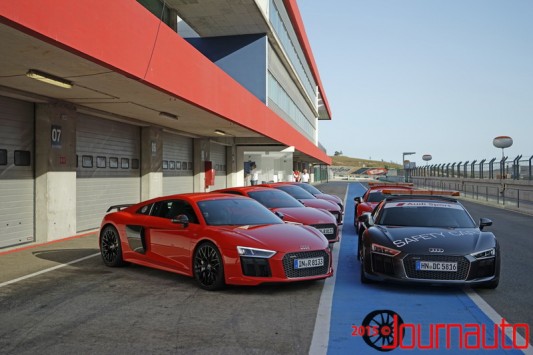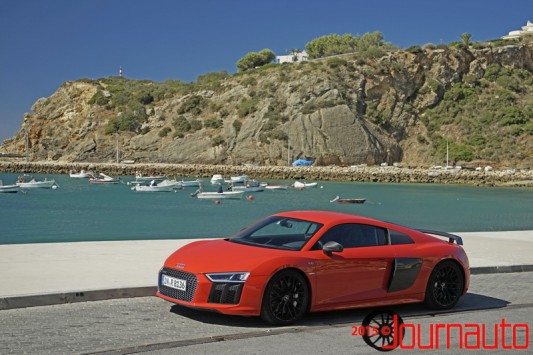From Le Mans To Your Driveway _

The Audi R8 supercar has been a bright star for the Four Rings since its 2007 debut. On the street and the racetrack. The company has sold nearly 27,000 of the road-going versions worldwide to date, and the second generation R8 – launched at the Geneva Motor Show last spring – is already on sale in Europe.
Audi’s most powerful and fastest production car will go on sale Canuck-side in spring 2016, though it will be a 2017 model (and virtually identical to the as-tested 2016MY). Pricing won’t be released until the spring, but rest assured it’ll offer an amazing performance-per-dollar value. Only V10 models will be offered, and a Spider model has not yet been announced. Based on current pricing, my best estimation is the 2017 Audi R8 will start at $185,000 for the base, and $215,000 for the V10 plus.
The current generation R8 is a reliable and functional everyday supercar, and badge stalwarts ought to be impressed when the green flag drops on this new and improved version. “It is simply a driver’s dream,” says Audi’s most decorated 24 Hours of Le Mans factory driver, Tom Kristensen, of his employer’s latest flagship. And there’s no point in arguing with a guy whose nickname is “Mr. Le Mans.”

Kristensen’s first Le Mans win with Audi came as part of a 1-2-3 podium sweep in 2000 when the R8 racecar made its debut. The R8 racecar enjoyed a three-year winning streak; and spawned the Audi Le Mans quattro concept car in 2003 to mark the achievement. Audi Sport Team Joest uses the R18 e-Tron quattro today for LMP action, but the homologated R8 is still a dominant force in the global motorsport arena.
No Audi model is closer to racing than the R8, and none are as dynamic as this new generation. Sharing 50 percent of their parts, the street and race versions were developed and launched simultaneously in Geneva. Ten weeks later, the no. 28 Audi Sport WRT R8 LMS had already won its first race – an overall victory at the ADAC Zurich 2015 24 Hours of Nürburgring no less.

Built in a new small-scale facility in Böllinger, Höfe operated by wholly owned subsidiary quattro GmbH, the 2016 R8 is hand-assembled alongside the Lamborghini Huràcan and their respective GT3 racing counterparts thanks to the group’s modular sportscar system (MSS). Although not an entirely new chassis, the Audi Space Frame has evolved significantly into an aluminum and carbon fibre reinforced plastic construction. Its 26 kilograms of carbon fibre that makes up the centre tunnel, b-pillars and rear firewall accounts for roughly one eighth of its total 1,454 kg dry/curb weight, with the rest coming in the form of extruded and die cast aluminum pieces more common to the MSS. When completely assembled, the 2016 chassis is 15 percent lighter and 40 percent stiffer than its predecessor.
Besides the partial tubbing in carbon, perhaps the most important differences lie in the b-pillar design and the beefed-up front structure. The R8’s trademark side-blade, which seemingly hovers above the body on the current R8, has been split up into two pieces that results in a more solid connection to the body. The 112-litre frunk (front trunk) is now fully integrated into the chassis to not only strengthen the nose, but also to help transmit frontal collision forces outward, backward and away from the driver. Audi has even developed a unique new alloy specifically for use in this frame. The end result is a stronger, more rigid platform that works amazingly well on the track or the street.
Continue reading my first drive review of the 2017 Audi R8 V10 Plus Coupe on the IGNITION LUXURY & PERFORMANCE website!


